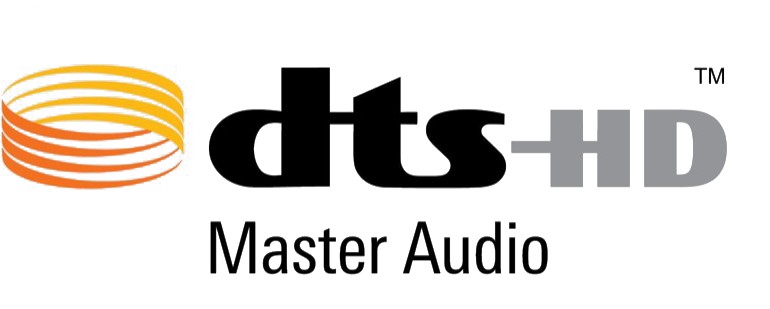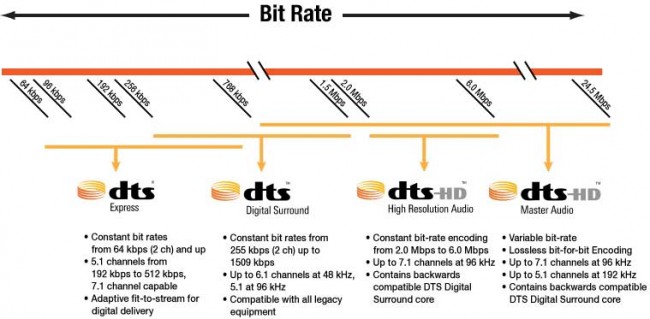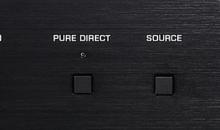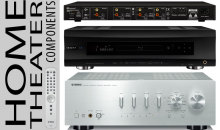What is DTS-HD and DTS-HD Master Audio?
When Blu-ray hit the scene and snuffed out (outspent, really) HD-DVD in the mini format war, a new audio CODEC was needed to handle the many ways in which audio would need to be delivered in the high-definition era. DTS-HD Master Audio (formerly known as DTS++) became the new defacto-standard for the premium level of on-disc HD audio. DTS-HD Master Audio is a “lossless” audio format—using a variable bit-rate technology to deliver high-quality audio while keeping file sizes small and conserving bandwidth. It turns out the format was an impressive jump over prior iterations of DTS and was light-years ahead in how it could communicate and transmit the required 7.1 sound for Blu-ray.
DTS (the company) set out to make DTS-HD Master Audio the audible equivalent of listening to the master recordings. Technically speaking, DTS-HD Master Audio carries within its file, two data streams: the original DTS “core” stream and another stream that contains the “residual” data that is made up of what’s left from the original signal and the lossy compressed stream. The decoder is then able to use both to recreate an audio stream that is bit-for-bit identical to the original (i.e. “lossless”). The encoding process is also very quick, and can be done in a single pass—something that is very important in the area of content creation and mastering.
Since DTS-HD Master Audio is essentially bit-for-bit identical to the studio master, it can also be used as an archival format, but while taking up dramatically less storage volume when compared to uncompressed PCM audio tracks.
With respect to the Blu-ray format, DTS-HD Master Audio is becoming popular as it offers significant space-savings, allowing for multiple languages to be stored on a single Blu-ray movie disc. This leaves more room for higher video quality, additional extras, and special features.
DTS is also completely backward-compatible, but in a way that allows legacy AV receivers and other products to playback DTS-HD Master Audio files at up to 1.5 Mbps with up to 7.1 discrete channels at 96 kHz or 5.1 channels at 192 kHz. Here’s what the various bit rates for DTS technologies look like:
Note that DTS-HD can output audio at up to 96 kHz sampling rates, but DTS-HD Master Audio can output 5.1 at up to 192 kHz. DTS-HD Master Audio also has a dramatic range where it can be encoded at a variable rate below 1 Mbps all the way up to around 24.5 Mbps. This is a flexible Mastering-level audio CODEC that has a lot of room for expansion and seems perfectly fit for all but the most aggressive surround formats of the future.
Do you notice the CODECs present on your Blu-ray discs? Ever purposefully select one over another when playing back a movie? Let us know if you have, and why on our Facebook page or leave a comment below.








I have played a BD movie with 5.1 DTS-MA through both the optical output to a processor, a combined processor/amplifier. The processor automiatically decoded a dts stream. I played the same movie whose player’s hdmi output went to an LPCM 7.1 decoder, like the Cypress CLUX-11SA or A3830A sold by Altronics (Australia). In this situation,
I understand to output LPCM via HDMI, the BD player converts the (compressed) DTS-MA stream to an uncompressed LPCM stream in order for the LPCM decoder to decode the stream.
A couple of questions please based on your article.
* Generally, when the BD player players DTS-5.1 MA, does the BD player pick up both the high ‘detailed’ information as well as the core ‘dvd’ quality information.
* Related to the first question. When the BD player plays the DTS-5.1 MA stream, through the optical (SPDIF) does the player just pick up the “core” 5.1 stream but discard the high resolution information.
* Similarly, I played a BD movie with a Dolby HD track. Is there the same principle of Dolby HD having a core stream ‘dvd’ quality and a high resolution stream. Again when I play the movie through the optical to a processor/amplifier, it is able to detect that it is Dolby digital.
* This is a question on perception of audio quality. I cannot perceive any difference in quality between optical audio which is dvd quality and HDMI audio lpcm. Or what am I supposed to perceive. For example should I use the Disney World of Wonder BD disk which is a test disk full of test sounds and test images. What attention should I pay in order to say, “…yes, there is a perceptible difference between dvd quality audio from the optical and HD audio via the HDMI….”
Thank you,
Anthony from Sydney Australia
I recently purchased from “Rhino Entertainment LLC & The Warner Music Group Company” a Box Set that contains four Blu Ray DVDs encoded in “dts-hd Master Audio.” The 4 albums are by the 70s rock band, The Doobie Brothers. This Blu-Ray Box Set of audio DVDs is billed as “The Doobie Brothers Quadio.”
I have two vintage 4-channel receiver units from the 1970s that still work: a Sansui QR 6500 and a Pioneer QX-949A. I just tried playing these audio DVDs through my old (2008) Panasonic DMP BD30 Blu Ray Disc player, with no luck. After several seconds, the display reads, “No Read.” I will assume that the player is too old to play these DVDs.
So, can you give me some advice: 1) Please suggest to me some typical (preferably low-priced) players for these types of Blu-Ray audio discs and 2) Do these new Blu-Ray players come with 4 analog RCA output jacks into which I can plug 4 RCA-type cables that will feed one of my 4-channel receivers?
Thanks for your time and expertise. Any assistance will be appreciated, Bill Audette
We’re only aware of a few reasons for that error: a bad disc, bad laser, or some issue with old firmware not recognizing an encoding format. However, that dts-hd Master Audio disc should have fallback audio that the player could read. If you can’t find updated firmware that fixes it, the problem may simply be the old player in combination with a newer disc (since I’m assuming it still reads other discs).
playing a bluray disc movie encoded with dts-hd master audio sending the audio thru hdmi will play the audio at 192 kilohertz., using a digital audio cable will only play that disc at 92 kilohertz. you will absolutely hear the (big) difference with 192 kilohertz. I tried it myself AND I WILL NEVER GO BACK TO THE 92 KILOHERTZ SOUND. thank you.
192 kilohertz is possible by using the hdmi for audio from a blu ray player when using 5 channel (5-speakers) only., using 7 channels the receiver is not able process audio at 192 kilohertz, it will run at 92 kilohertz only. thank you.